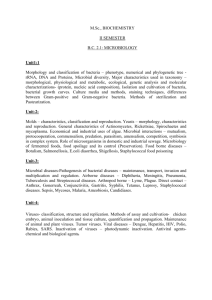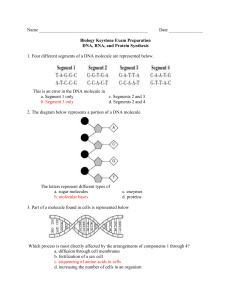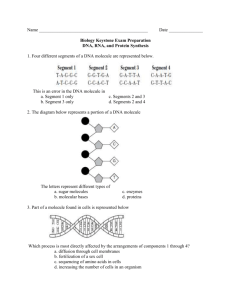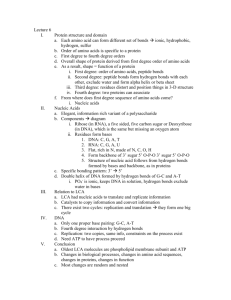M.Sc., BIOCHEMISTRY II SEMESTER B.C. 2.1: MICROBIOLOGY
advertisement
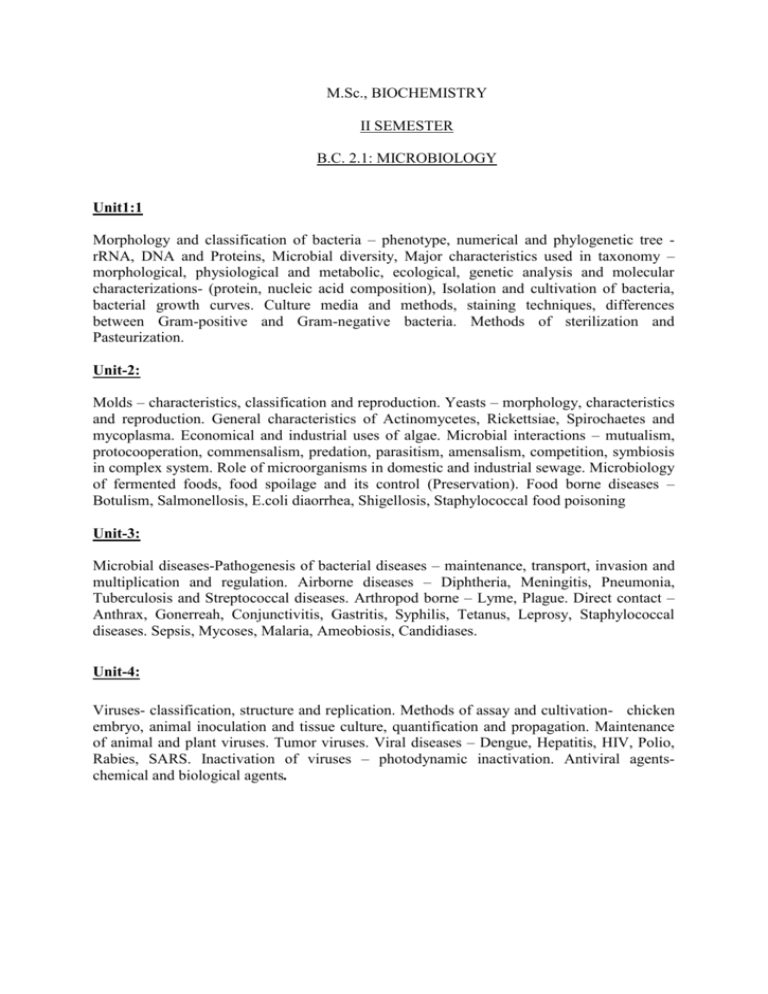
M.Sc., BIOCHEMISTRY II SEMESTER B.C. 2.1: MICROBIOLOGY Unit1:1 Morphology and classification of bacteria – phenotype, numerical and phylogenetic tree rRNA, DNA and Proteins, Microbial diversity, Major characteristics used in taxonomy – morphological, physiological and metabolic, ecological, genetic analysis and molecular characterizations- (protein, nucleic acid composition), Isolation and cultivation of bacteria, bacterial growth curves. Culture media and methods, staining techniques, differences between Gram-positive and Gram-negative bacteria. Methods of sterilization and Pasteurization. Unit-2: Molds – characteristics, classification and reproduction. Yeasts – morphology, characteristics and reproduction. General characteristics of Actinomycetes, Rickettsiae, Spirochaetes and mycoplasma. Economical and industrial uses of algae. Microbial interactions – mutualism, protocooperation, commensalism, predation, parasitism, amensalism, competition, symbiosis in complex system. Role of microorganisms in domestic and industrial sewage. Microbiology of fermented foods, food spoilage and its control (Preservation). Food borne diseases – Botulism, Salmonellosis, E.coli diaorrhea, Shigellosis, Staphylococcal food poisoning Unit-3: Microbial diseases-Pathogenesis of bacterial diseases – maintenance, transport, invasion and multiplication and regulation. Airborne diseases – Diphtheria, Meningitis, Pneumonia, Tuberculosis and Streptococcal diseases. Arthropod borne – Lyme, Plague. Direct contact – Anthrax, Gonerreah, Conjunctivitis, Gastritis, Syphilis, Tetanus, Leprosy, Staphylococcal diseases. Sepsis, Mycoses, Malaria, Ameobiosis, Candidiases. Unit-4: Viruses- classification, structure and replication. Methods of assay and cultivation- chicken embryo, animal inoculation and tissue culture, quantification and propagation. Maintenance of animal and plant viruses. Tumor viruses. Viral diseases – Dengue, Hepatitis, HIV, Polio, Rabies, SARS. Inactivation of viruses – photodynamic inactivation. Antiviral agentschemical and biological agents. B.C: 2.2: CELL BIOLOGY AND GENETICS Unit-1 Structure of a typical cell, Differences between prokaryotic and eukaryotic cells, animal and plant cells. Cytoskeleton – microtubules, microfilaments, Epithelial tissue, Basement membrane, Extracellular matrix – collagen, elastin, fibrillin, fibronectin, laminin, proteoglycans, integrins. Autocrine, paracrine, exocrine and endocrine systems, , Molecular mechanism of signal transduction (Biosignalling), G proteins, Second messenger system – c AMP, cGMP, Calcium, IP3, DA G, nitric oxide, Mechanism of their generation and action. Role of different protein kinases. Unit-2 Cell receptors - nature and types of receptors, ligand and receptor interaction, up and down regulation of receptors. Chromatin organization – euchromatin and heterocromatin, telomere, centromere, Cell division by mitosis and meiosis, Cell cycle and its regulation, Apoptosis, Biochemistry of cancer – carcinogenesis, characteristics of cancer cell, Agents promoting carcinogenesis. Unit-3 Mendel’s experiments as an example of good scientific technique, Genotype and phenotype; Genotype-environment interaction; Norm of reaction, Developmental Noise; Concept of Dominance; Penetrance and expressivity; Concept of alleles- Multiple alleles, Test for allelism, types of alleles, Benzer’s rII alleles; Concept of cistron, recon, and muton; Interaction between genes - Modified dihybrid ratios; Sex determination with special reference to genetic basis of sex determination in humans-sry gene; Sex linked inheritance. Unit-4 Linkage and crossing over- 2 point test cross, 3 point test cross, recombination as a basis for variation; Quantitative inheritance; Extra chromosomal inheritance; Concept on origin of mutations taking bacteria as an example-Classical experiments of Luria and Delbruck, Newcombe and Lederberg – Fluctuation test, Plate spreading, Replica plating and Sib selection; Mutations – Types of mutations, Mutagens and their mechanism of action, Molecular mechanism of mutations; Modern concept of the gene-Split gene; Overlapping genes, Assembled genes, Repeated genes, Polyprotein genes, Nested genes. BC 2.3: INTERMEDIARY METABOLISM Unit-1: Approaches for studying intermediary metabolism. Glucose as fuel, glucose transporters, Glycolysis and its regulation. Substrate cycling, TCA cycle – function and regulation, Glyoxylate cycle, Gluconeogenesis and its regulation, HMP shunt and its significance, Uronic acid pathway, Glycogen metabolism and its regulation with special reference to phosphorylase and glycogen synthase, Metabolism of fructose, galactose and lactose, Biogenesis of amino sugars, peptidoglycans, glycosyl aminoglycans and glycoproteins. In born errors of carbohydrate metabolism. Unit-2: Proteins turn over – Role of ubiquitin. General metabolic reactions of amino acids. Metabolic breakdown of individual amino acids. Ketogenic and glycogenic amino acids. Formation of creatinine, ammonia and urea. Regulation of urea cycle. Essential and non-essential amino acids. Biosynthesis and regulation of branched chain amino acids, aromatic amino acids, histidine and methionine. In born errors of amino acid metabolism. Unit-3: Fats as energy stores, Oxidation of fatty acids, Formation and utilization of ketone bodies. Biosynthesis of fatty acids and regulation. Metabolism of arachidonic acid – formation of prostaglandins, thromboxanes, leucotrienes. Biosynthesis of triglycerides. Metabolism of phospholipids, sphingolipids. Biosynthesis of cholesterol and its regulation, Formation of bile acids. Role of liver and adipose tissue in lipid metabolism. In born errors of lipid metabolism Unit-4: Biosynthesis and degradation of purines and pyrimidines and their regulation. Structure and regulation of ribonucleotide reductase. Biosynthesis of ribonucleotides, deoxyribonucleotides and polynucleotides. Inhibitors of nucleic acid biosynthesis. Biosynthesis and degradation of heme. In born errors of nucleic acid and porphyrin metabolism. BC: 2.4: MOLECULAR BIOLOGY Unit-1: Models of DNA Replication, Origin and direction of replication, Semidiscontinuous replication, DNA polymerases of prokaryotes and their mechanism of action; Primase, Ligase, Single strand DNA binding protein, Helicase, Topoisomerases Replication strategies for replicating circular DNA: mode replication, mode or rolling circle replication and D-loop replication. Eucaryotic DNA polymerases, Reverse transcriptase, Strategies for replicating linear DNA, Fidelity and processivity of replication, Inhibitors of replication. Unit-2: DNA Repair mechanisms, Photoreactivation, Excision repair mechanism, Post replication repair mechanisms - recombination repair, mismatch repair system, SOS response, transcription-repair coupling. Recombination - models of general recombination; Hollyday model, asymmetric strand transfer model, double strand break repair model, site-specific recombination. Transposition of DNA; Transposable elements, Prokaryotic transposons, Eukaryotic transposons, Retroposons. Unit-3: Principles of transcription, Prokaryotic RNA polymerase, Conserved sequences of prokaryotic promoters, Initiation of transcription, Chain elongation, Chain termination, Eukaryotic RNA polymerases, Conserved sequences of eukaryotic promoters, Transcriptional factors and basal eukaryotic transcription complex, Enhancers, Transcriptional termination in eukaryotes Post transcriptional processing of pre-mRNA - addition of Cap to the 5’ end, Polyadenylation to the 3’ end, mechanism of intron removal and exon splicing, Procesing of r-RNA, Self-splicing of group-1 and group-11 introns, Processing of tRNA, RNA editing changes. Unit-4: General features of genetic code, Structural components of prokaryotic and eukaryotic ribosomes, Mechanism of protein synthesis in prokaryotes and eukaryotes - aminoacylation of tRNA, protein synthesis - initiation, elongation and chain termination, Protein synthesis inhibitors, Translational control in eukaryotes, Protein targetting and processing; Singal sequences, signal recognition particle, signal hypothesis, molecular chaperons. PRACTICAL – I BC: 2.5: MICROBIOLOGY AND GENETICS Sterilization Techniques-Autoclaving, hot-air oven sterilization, Sieve filtration, membrane filtration. Preparation of culture media – Nutrient Broth, Nutrient Agar, Blood agar MacConkey’s agar, Potato dextrose agar. Isolation of bacteria – Streak plate and pour plate methods. Motility of Bacteria – “Hanging drop” technique Bacteriological examination of water and milk Bacterial growth curve Identification of bacteria by staining techniques – simple, differential, Gram staining and acid-fast staining. Identification of bacteria – Morphological, cultural and biochemical characteristics Microbiological assay of a vitamin/amino acid Analysis of domestic and industrial effluents - MPN, BOD, COD and DO Isolation of phage and plaque formation units (PFU) Mitosis in onion root tip cell Meiosis in onion flower buds Karyotyping Problems on monohybrid ratio, dihybrid ratio, gene interaction, linkage and crossing over – 2 point test cross. PRACTICAL – II BC: 2.6: QUANTITATIVE ANALYSIS AND MOLECULAR BIOLOGY Determination of Pka and PI values of an amino acid by titrimetric method Estimation of proteins by Lowry, Bradford methods Determination of carbohydrates by Anthrone method Determination of RM value and polensky number of oils Estimation of pyruvate by 2,4 Dinitrophenyl hydrazine method Estimation of Ca++/Zn ++ by EDTA titrimetric method Determination of melting temperature (Tm ) of DNA Isolation of DNA from bacterial, plant and animal cells. Estimation of DNA by Diphenylamine method. Isolation of RNA from yeast cells. Estimation of RNA by Orcinol method. Estimation of DNA and RNA by UV absorption method and determination of purity of nucleic acids. Determination of sugar and phosphate ratios in DNA and RNA samples. Conjugation: Use of broad host range plasmid RP in demonstrating conjugation transfer of plasmid bacteria. Catabolite repression: Evidence of B-Galactosidase induction in presence of lactose in E.coli lac strains. Mutations: UV damage and repair mechanism in Escherichia coli Or Seratia marcesens Strain improvement of Aspergillus niger using chemical mutagen – Ethidium bromide
